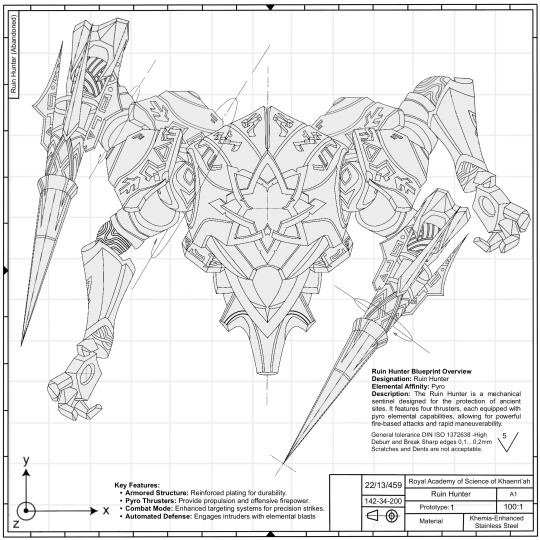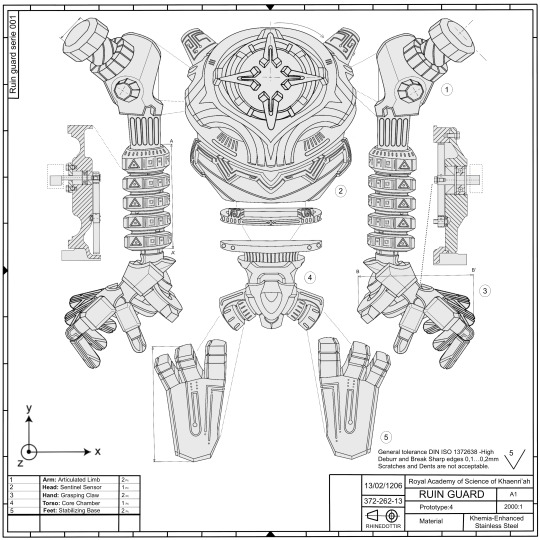A Khaenri’ahn scientist's Research Log | RP“To understand the unknown, one must first abandon the fear of it.”· · ─────── ·𖥸· ─────── · ·🔹 Art Blog: PearlGodaymen
Last active 60 minutes ago
Don't wanna be here? Send us removal request.
Text

Royal Academy of Science of Khaenri’ah Project: Black Serpents - Windcutter Initiative Research Log #001 Lead Researcher: [Name Redacted] Date: 22/13/1459
⊹˚₊‧───────────────‧₊˚⊹
Initial Development & Purpose:
The Black Serpents were developed as an elite autonomous soldier unit, designed to operate with both precision and agility. Unlike traditional automatons, these units were engineered with an Anemo-powered framework, enhancing both their mobility and adaptability in combat. Their purpose was twofold: eliminate high-priority threats and engage fortified adversaries, particularly those utilizing defensive shielding techniques. The development of the Windcutter Variant introduced a novel blade manipulation system, allowing for increased offensive versatility. These units were not only capable of wielding swords with expert-level proficiency but could also launch spinning blade projectiles and perform whip-like slashes, overwhelming opponents with unrelenting speed.
Design & Functionality:
Anemo-Powered Combat System – The Windcutters utilize Anemo energy to enhance both mobility and offensive capabilities, ensuring rapid repositioning and attack execution. Adaptive Strike Mechanisms – The units execute both two- and three-strike blade combos, delivering high-impact Anemo-infused slashes. Against shielded opponents, Windcutters adapt by increasing attack speed and power. Blade Projection System – Equipped with Whirling Windblades, allowing the unit to launch multiple spinning sword projectiles before retracting them for further strikes. Tactical Maneuvers & Countermeasures – When an attack is fully absorbed by an enemy’s shield, the unit sacrifices 15% of its current vitality to gain a temporary power buff and the ability to blink-evade the next incoming strike. Swiftwind Arsenal – The unit can generate and fire six projectile seekers, tracking and overwhelming enemies from a distance.
Strategic Deployment & Weaknesses:
Windcutters were assigned to high-security divisions of Khaenri’ah’s military forces, serving as elite guards of the monarchy and strategic enforcers. Each was trained—or rather, programmed—with an advanced sword art known as "Truthseeker," emphasizing precise, relentless strikes. However, the design carries inherent risks. Their reliance on Anemo energy leaves them susceptible to disruption when their power flow is interrupted. Additionally, their aggressive counter-shield tactics result in self-inflicted energy loss, making prolonged engagements costly.
Operational History & Legacy:
Records suggest that these warriors once stood alongside the Twilight Sword, with some of their number lost to history following the collapse of Khaenri’ah. Surviving units were later encountered in the ruins of The Chasm and other forgotten battlegrounds, their programming still compelling them to fight for a kingdom that no longer exists. Some Windcutters bear distinct designations, such as: Edgetho, Breaker of the Oath of Silence Buliwyf, Guardian of the Desolation Rethel, Slain of the Split Bow Ynghildr, Sword of a Lost Homeland Despite their fractured directives, they remain fearsome warriors, remnants of a dying empire’s final stand.
End of Log.
#BlackSerpentKnights#Windcutter#Khaenriah#AutomatonWarfare#PreCataclysmLogs#GenshinImpactRP#KhaenriahScience#ResearchLogs#Swordmasters#GenshinLore#genshin impact#fanart
0 notes
Text

Royal Academy of Science of Khaenri’ah Project: Ruin Hunter Initiative Research Log #001 Lead Researcher: [Name Redacted] Date: 22/13/1459 ⊹˚₊‧───────────────‧₊˚⊹
Initial Development & Purpose:
The Ruin Hunter Initiative was developed as the next step in Khaenri’ah’s automated warfare program, following the limitations observed in humanoid Ruin Machines. Seeking to improve combat effectiveness, our engineers opted for an advanced multi-limbed design, prioritizing enhanced mobility, targeting precision, and aerial superiority. Unlike the previous Field Tillers, the Ruin Hunters were designed to operate independently across various combat scenarios, capable of both close-quarters combat and long-range bombardment. Their ability to enter an airborne state significantly increased battlefield survivability while exposing enemy vulnerabilities.
Design & Functionality:
Armored Structure – The Ruin Hunter’s reinforced plating ensures maximum durability, reducing susceptibility to traditional weaponry and increasing resistance against elemental attacks. Pyro Thrusters – Integrated propulsion systems provide maneuverability and enhance offensive capabilities, allowing high-speed repositioning and fire-based assaults. Enhanced Combat Systems – The unit is equipped with precision-based melee attacks, including blade slashes, spinning slashes, and drill thrusts, ensuring versatility in both defensive and offensive strategies. Automated Defense Systems – When airborne, the Ruin Hunter engages in bombardment protocols, deploying guided missiles, focused beams, and quad laser strikes to eliminate targets at range.
Adaptive Combat Behavior:
The Ruin Hunter exhibits intelligent engagement strategies, prioritizing enemies based on their position and movement. If a target remains distant or is positioned at a different elevation, the unit will activate its airborne state, detaching its limbs for enhanced propulsion. In this state, the unit becomes significantly more dangerous, unleashing devastating aerial bombardments.
Weaknesses & Countermeasures:
Despite its superior design, the Ruin Hunter has a known vulnerability: its core sensor is only exposed when airborne. By striking this weak point with sufficient force, the unit can be forcibly deactivated for a short period, disrupting its attack cycle and leaving it open to damage.
Operational History & Legacy:
The Ruin Hunters were among the final advancements in Khaenri’ah’s autonomous warfare project, assigned unique designations under the "Fo-" classification. However, following the kingdom’s downfall, these units, like their predecessors, were left scattered and masterless. Many continue to operate, patrolling long-abandoned ruins and responding aggressively to perceived threats. Their sheer destructive capability stands as a haunting testament to Khaenri’ah’s ingenuity and the devastating potential of unchecked war machines.
End of Log.
#RuinHunterInitiative#Khaenriah#RuinHunter#AutomatonWarfare#PreCataclysmLogs#GenshinImpactRP#KhaenriahScience#ResearchLogs#MechanicalWarfare#GenshinLore#genshin impact#fanart#rp
3 notes
·
View notes
Text

Royal Academy of Science of Khaenri’ah Project: Ruin Drake Initiative Research Log #001 Lead Researcher: [Name Redacted] Date: 13/06/1206 ⊹˚₊‧───────────────‧₊˚⊹
Initial Development & Purpose:
Following the success of the Field Tiller Initiative, the Ruin Drake Initiative was commissioned to further advance Khaenri’ah’s autonomous warfare capabilities. Unlike their predecessors, these units were designed not only for combat adaptability but for elemental resistance and counteraction. The inspiration for the Ruin Drakes came from the Vishaps, ancient lifeforms known for their ability to absorb and counteract elemental forces. To replicate this ability, these machines were designed with a specialized Energy Surge System, allowing them to analyze and convert absorbed elemental energy into a reinforced defensive state and offensive retaliation. These units were built with both terrestrial and aerial variants to ensure strategic superiority. The development of stabilizing wings allowed flight-capable models to engage in long-range suppression and evasive maneuvers, further enhancing their role in battlefield domination.
Design & Functionality:
Articulated Tail System – The primary striking and defensive mechanism. The tail is reinforced with Khemia-enhanced alloys, capable of devastating impact force and high-speed rotational strikes. Sentinel Sensor Head – The core of the Ruin Drake’s targeting and adaptive processing system. Capable of tracking elemental imbalances and calibrating attack strategies accordingly. Grasping Claw Mechanism – Designed for both environmental traversal and close-range combat. The claws enable grappling and terrain manipulation, allowing the Ruin Drake to anchor itself in dynamic combat situations. Core Chamber – The power unit, housing the Chaos Storage System, which enables the machine’s absorption and conversion of elemental energy. Stabilizing Wings – Primarily utilized by aerial variants, these mechanical wings provide increased mobility, allowing for both evasive maneuvers and high-speed dives to strike ground-based targets.
Adaptive Combat Behavior:
The Energy Surge System is the Ruin Drake’s defining feature. When exposed to continuous elemental damage, the unit absorbs the most prominent energy type, adapting its resistance accordingly. Once fully charged, the unit retaliates with a converted elemental surge, altering its primary attack type to match the absorbed element.
Weaknesses & Countermeasures:
Despite its formidable adaptability, the Ruin Drake has structural vulnerabilities. Its thrusters, wing joints, and nasal sensor unit are weak points that, when struck with sufficient force, can cause temporary paralysis. If a Ruin Drake is stunned while it has absorbed an element, the stored energy is forcibly discharged, resetting its adaptive state.
Operational History & Legacy:
The Ruin Drake Initiative was meant to mark a new era in autonomous warfare, with prototypes designated under the "Faf-" (for Fafnir) classification, each assigned a unique numerical identifier. However, as with the Field Tillers, these machines were left without masters following the destruction of Khaenri’ah. The surviving units remain scattered across Teyvat, continuing their programming in isolation. While many have become dormant or inactive, others persist, mimicking the Vishaps they were modeled after, responding to threats with ruthless efficiency. To this day, they stand as remnants of a lost empire, their purpose unchanged despite the passage of time.
End of Log.
#RuinDrakeInitiative#Khaenriah#RuinDrake#AutomatonWarfare#PreCataclysmLogs#GenshinImpactRP#KhaenriahScience#ResearchLogs#MechanicalWarfare#GenshinLore#genshin impact#genshin rp#technology#mecha#lore
9 notes
·
View notes
Text

Royal Academy of Science of Khaenri’ah Project: Field Tiller Initiative Research Log #001 Lead Researcher: [Name Redacted] Date: 13/03/1206 ⊹˚₊‧───────────────‧₊˚⊹
Initial Development & Purpose:
The Field Tiller Initiative was developed as a mechanized military defense system for Khaenri’ah. These units were designed to be autonomous combat automatons, capable of engaging in battle without human intervention. The concept arose from the belief that "the land is not to be tilled with farming tools, but rather is to be fought for with steel and blood."
Each Field Tiller unit possesses enhanced combat capabilities and was engineered to function in various terrains. Following the destruction of Khaenri’ah, these machines, left without masters, continued operating independently, spreading across Teyvat.
Design & Functionality:
Articulated Limb Systems - The unit’s arms feature reinforced servos and hydraulics, providing significant striking power. Each limb is capable of delivering rapid spinning strikes and powerful stomping motions, dealing high-impact damage to targets. Sentinel Sensor Head - The optical core serves as both the targeting system and control hub. It tracks enemy movement and executes calculated attacks. However, if struck twice in rapid succession, the unit enters a temporary shutdown state, exposing it to further damage. Grasping Claw Mechanism - Engineered for both combat and environmental manipulation. The claws allow the unit to engage in crushing attacks and provide stability in rough terrain. Core Chamber - The central power unit, housing an energy source that sustains the automaton’s functions. This core is integral to the machine’s continued operation, though it remains vulnerable to certain forms of damage. Stabilizing Base & Mobility System - Although initially designed for stationary defense, modifications enabled these units to traverse landscapes, engage in close-range combat, and execute aerial maneuvers.
Combat Behavior:
Field Tillers exhibit multiple attack patterns based on proximity and threat level: Melee Strikes – Engages enemies in close range using spinning punches, stomps, and clapping motions to inflict heavy damage. Suppressive Volley – When facing distant threats, the unit launches guided missile attacks from its back-mounted cannons, tracking targets with high precision. Spiral Close-In – Initiates a spinning advance toward the enemy, extending its reach and dealing sustained damage over time. Defensive Measures – If the optical core is struck once, the unit momentarily staggers; a second strike disables it for a short duration. Once reactivated, protective runes prevent immediate deactivation but do not eliminate weak point vulnerability.
Operational History & Legacy:
Field Tillers were originally developed as weapons of war for Khaenri’ah’s defense. After the kingdom’s fall, they persisted as remnants of a lost era, scattered across Teyvat. The modern world has come to know them as "Ruin Guards," mistaking them for sentinels of ancient ruins rather than the mechanized soldiers they were built to be. Many of these units remain functional, continuing their original programming in the absence of command. Some have degraded, falling into disrepair, while others still roam battlefields long since abandoned, attacking any perceived threats in their path. Certain units bear serial codes beginning with "Hu," followed by a numeric designation. These numbers, assigned during production, suggest a vast network of machines, many of which remain undocumented. Whether these units will remain as relics of the past or be reawakened for another purpose remains uncertain.
End of Log.
#FieldTillerInitiative#Khaenriah#RuinGuard#AutomatonWarfare#PreCataclysmLogs#GenshinImpactRP#KhaenriahScience#ResearchLogs#MechanicalWarfare#GenshinLore#Technology#SF#genshin impact#genshin rp
2 notes
·
View notes